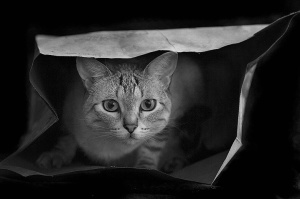Although popularised by Crooks & Soulé (1999), Soulé et al. (1988) first gave us the term that described how entire ecosystems can become unbalanced by a reduction of a higher trophic-level predator exerting so-called ‘top-down’ control on the abundance of species occupying lower trophic levels.
The idea had theoretical support in ecology (Wright et al. 1994; Litvaitis & Villafuerte 1996), but it was not until Soulé and colleagues described how the decline of dominant predators combines with habitat fragmentation to release top-down pressure on smaller predators, thereby increasing predation rates on prey lower down the trophic web.
Crooks & Soulé (1999) described an example where the decline in coyotes (Canis latrans) in combination with urbanisation-driven habitat fragmentation led to an increase in cat (Felis catus) densities and the subsequent decline in scrub-breeding birds. More recent examples attest to the importance of the mesopredator release phenomenon: Myers et al. (2007) described how the decline in large coastal shark species has allowed mesopredator cownose rays (Rhinoptera bonasus) to increase, leading to a reduction in commercially important shellfish densities; and Johnson et al. (2007) showed how dingoes (Canis lupus dingo) in Australia suppress populations of exotic predators such as cats and foxes, leading to more locally abundant populations of native marsupials (see previous post).
Conservation biologists have benefited from this knowledge because we’ve realised that top-order predators affect far more than their immediate prey. These examples really hit home how a fully functional community is required for ecosystem stability, so we should strive to preserve complete complements of communities, not just our favourite species.














[…] smaller introduced predators like foxes and cats, in areas where dingoes are abundant [244, 245]. In other situations, we can implement Trap-Neuter-Release, or sterilisation programs [246]. […]
LikeLike
[…] of Mr. Fox and the persecution of Australia’s top predator, the dingo, this wily little mesopredator has been implicated in the extinction of around 20 native mammals, and has a habit of predating on […]
LikeLike
[…] pressure on smaller predators, thus limiting the latter’s intake of other fish species. Removing the biggest predators means that smaller predators increase, which then quickly eat other species that keep things like algae in check. The overall effect is […]
LikeLike
[…] the important regulating role of predators in myriad systems. We have written extensively on the mesopredator release concept applied to dingos,sharks and coyotes, but we haven’t really expanded on the broader […]
LikeLike
[…] the essential ecosystem functions of these species (see former posts on CB.com here, here and here). The review focuses on the largest and most well-studied species, but the trends likely apply […]
LikeLike
[…] which smaller mesopredators become the new top predators of over-exploited communities—keep sprouting everywhere on land and in the water2. Mulling over this state of affairs, it dawned on me one day that understanding how antipredator […]
LikeLike
I drew a geeky comic related to this topic. Check it out:
http://adamsapple2day.blogspot.com/2013/02/mesopredator-release-comic.html?showComment=1361251108337#c1649408433846986861
LikeLike
[…] the important regulating role of predators in myriad systems. We have written extensively on the mesopredator release concept applied to dingos, sharks and coyotes, but we haven’t really expanded on the broader […]
LikeLike
[…] can read more about “mesopredator release” here and here. And you can read about humans as apex predators […]
LikeLike
[…] when dingoes are abundant, foxes and cats aren’t, and native marsupials are. It’s called the “mesopredator” effect, and highlights the important role of predators in maintaining healthy […]
LikeLike
[…] of Mr. Fox and the persecution of Australia’s top predator, the dingo, this wily little mesopredator has been implicated in the extinction of around 20 native mammals, and has a habit of predating on […]
LikeLike
[…] removal of foxes in Western Australian forests may have led to mesopredator release of cats, and thus an increase in predation pressure on a suite of native fauna. This process may […]
LikeLike
[…] of maintaining top predators in guarding ecosystem health cannot be understated (see previous posts here, here and here); and 2. It’s not just an immediate benefit – entire communities slowly […]
LikeLike